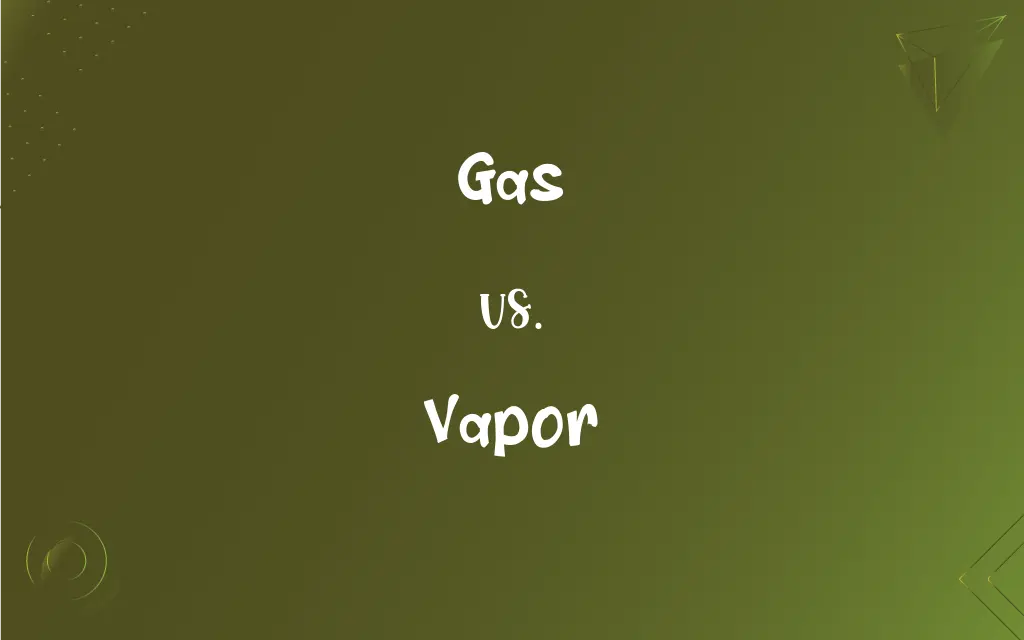Gas vs. Vapor: What's the Difference?
Edited by Aimie Carlson || By Harlon Moss || Updated on October 7, 2023
Gas is a form of matter that fills any available space; vapor is the gaseous state of a substance that's normally liquid or solid at room temperature.

Key Differences
Gas is one of the four fundamental states of matter. It doesn't have a fixed shape or volume and will expand to fill any available space. On the other hand, vapor refers to the gaseous state of a substance that is primarily in solid or liquid form at room temperature.
In terms of intermolecular forces, gases consist of molecules that are far apart and have weak intermolecular attractions. Vapor, however, arises from the evaporation of a liquid or sublimation of a solid, and can often be returned to its original state with ease.
A gas can exist at room temperature and pressure, such as oxygen or nitrogen. Vapor, conversely, is often associated with the change of state process, like when water turns to steam.
Gases are usually considered in a broader scope, while vapor is more specific to substances transitioning between states. For instance, we breathe in oxygen gas, but we see water vapor in the air after a hot shower.
Lastly, while both gas and vapor can be invisible, vapor can often be seen when it condenses into small liquid droplets in the air, such as in the form of clouds or fog. Gas, by its inherent nature, does not undergo such visible condensation under typical conditions.
ADVERTISEMENT
Comparison Chart
State of Matter
One of the four fundamental states.
Gaseous state of a substance typically liquid/solid at room temp.
Origins
Can exist naturally at room temp and pressure.
Arises from evaporation of liquid or sublimation of solid.
Visibility
Typically invisible.
Can become visible when it condenses (e.g., fog).
Reversibility
Does not easily return to liquid or solid form.
Can be easily condensed back to its liquid or solid form.
Intermolecular Forces
Molecules far apart with weak attractions.
Can have stronger attractions compared to gases due to its origin.
ADVERTISEMENT
Gas and Vapor Definitions
Gas
A substance in a state where it expands freely to fill any space available.
Helium gas fills balloons, making them float.
Vapor
The gaseous form of substances that are normally in a liquid or solid state.
Water turns into vapor when boiled.
Gas
A fluid without a fixed shape that takes the shape of its container.
Neon gas illuminates signs in a distinct bright color.
Vapor
Visible mist or cloud of water particles suspended in the air.
Hot water produces vapor in cold air.
Gas
A combustible substance used as fuel.
The stove runs on natural gas.
Vapor
Something unsubstantial or transitory.
Dreams vanish like vapor upon waking.
Gas
Air-like fluid substance which can spread out indefinitely.
Nitrogen gas makes up about 78% of Earth's atmosphere.
Vapor
A substance diffused or suspended in the air.
The aroma of freshly baked bread filled the room as vapor.
Gas
Any non-solid, non-liquid substance.
Oxygen gas is essential for human respiration.
Vapor
Exhalations of bodily organs, often invisible and odorous.
The smell of menthol vapor is often used in cold remedies.
Gas
The state of matter distinguished from the solid and liquid states by relatively low density and viscosity, relatively great expansion and contraction with changes in pressure and temperature, the ability to diffuse readily, and the spontaneous tendency to become distributed uniformly throughout any container.
Vapor
The gaseous state of a substance that is liquid or solid at room temperature.
Gas
A substance in the gaseous state.
Vapor
A faintly visible suspension of fine particles of matter in the air, as mist, fumes, or smoke.
Gas
Any of various mixtures of flammable gases used for lighting, heating, or cooking.
Vapor
A mixture of fine droplets of a substance and air, as the fuel mixture of an internal-combustion engine.
FAQs
What is gas in terms of state of matter?
Gas is one of the four fundamental states of matter with no fixed shape or volume.
Is steam a gas or a vapor?
Steam is water in its vapor form.
Do gases have fixed volumes?
No, gases do not have a fixed volume; they expand to fill their container.
Are the terms gas and vapor interchangeable?
While often used interchangeably, they have distinct definitions; all vapors are gases, but not all gases are vapors.
Can vapor be seen?
Vapor can become visible when it condenses, like fog or steam.
Can vapors originate from solids?
Yes, when solids sublimate, they directly turn into vapor.
Can vapor be scented?
Yes, vapor can carry the scent of its origin, such as the aroma from cooked food.
What is vapor in relation to its usual state?
Vapor is the gaseous state of a substance typically found as a liquid or solid at room temperature.
Do all gases condense into liquids?
No, not all gases easily condense into liquids under typical conditions.
What makes up the majority of our atmosphere?
The atmosphere is primarily composed of nitrogen gas.
Is air a gas?
Yes, air is a mixture of gases primarily composed of nitrogen and oxygen.
Is every vapor a gas?
Yes, every vapor is in a gaseous state, but not every gas is a vapor.
Can gas be a fuel source?
Yes, certain gases like natural gas are used as fuel sources.
What's the primary difference between gas and vapor?
Gas is a broad term for a state of matter, while vapor specifically refers to the gaseous state of substances usually solid or liquid at room temperature.
What is the visible mist in cold weather?
It is water vapor condensing in the cold air.
Why do we see vapor after a hot shower?
The hot water increases the rate of evaporation, producing water vapor that can condense in the cooler air, making it visible.
Can all matter exist as gas?
With enough heat, most substances can be vaporized into a gaseous state.
How is vapor pressure related to vapor?
Vapor pressure is the pressure exerted by a vapor in equilibrium with its liquid or solid form.
Can vapors be harmful?
Yes, some vapors, like those from chemicals, can be harmful when inhaled.
Is dry ice a gas or vapor?
Dry ice sublimates, turning directly into carbon dioxide vapor.
About Author
Written by
Harlon MossHarlon is a seasoned quality moderator and accomplished content writer for Difference Wiki. An alumnus of the prestigious University of California, he earned his degree in Computer Science. Leveraging his academic background, Harlon brings a meticulous and informed perspective to his work, ensuring content accuracy and excellence.
Edited by
Aimie CarlsonAimie Carlson, holding a master's degree in English literature, is a fervent English language enthusiast. She lends her writing talents to Difference Wiki, a prominent website that specializes in comparisons, offering readers insightful analyses that both captivate and inform.































































